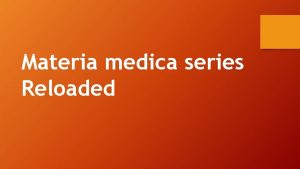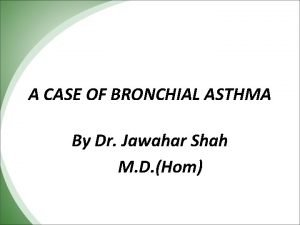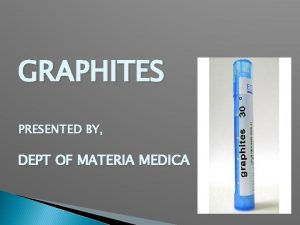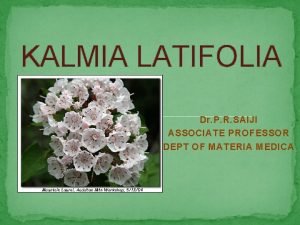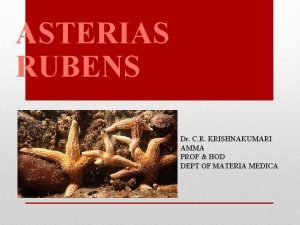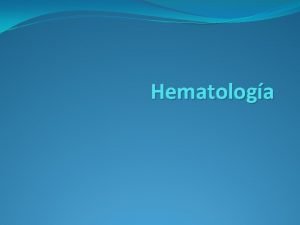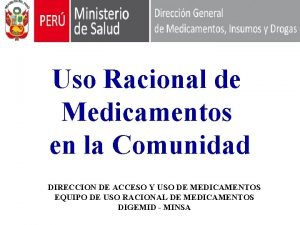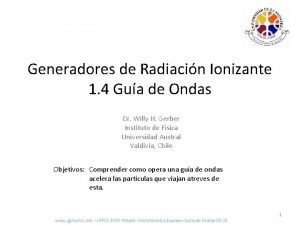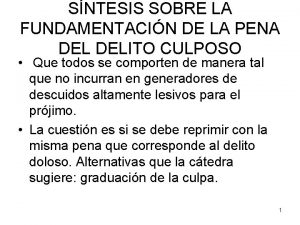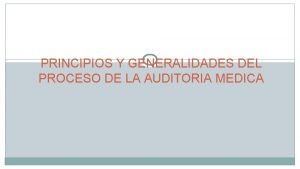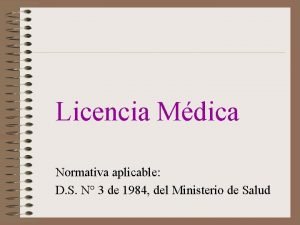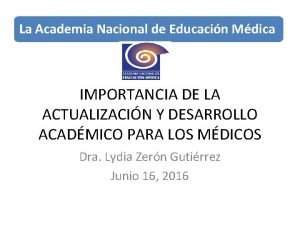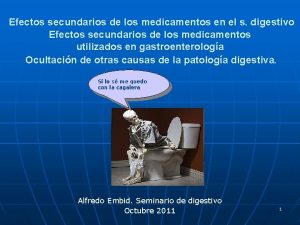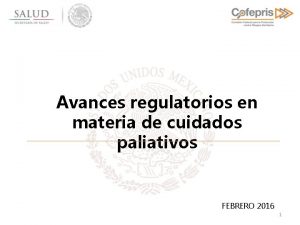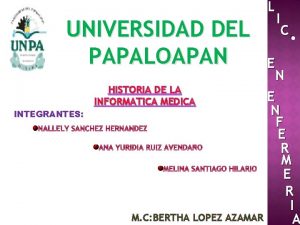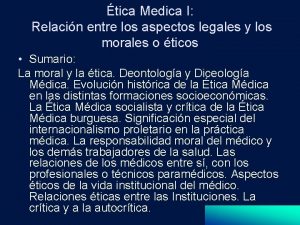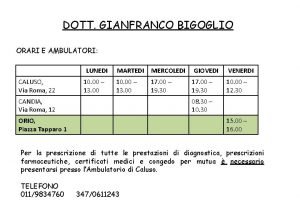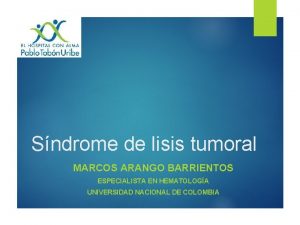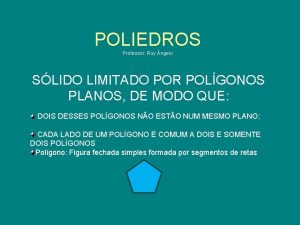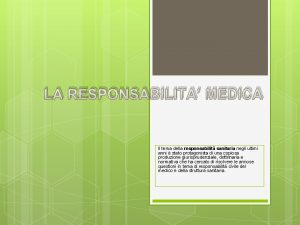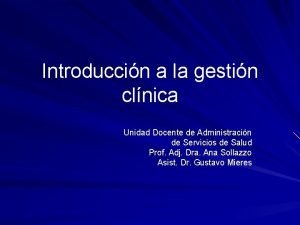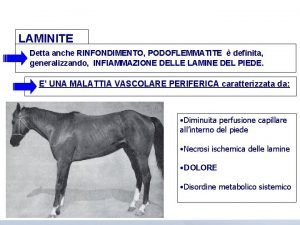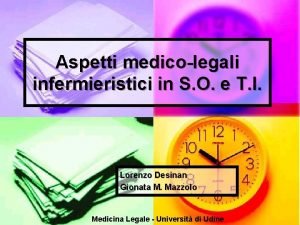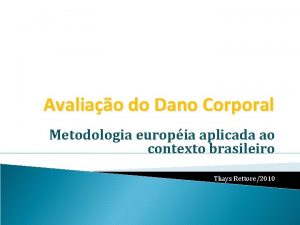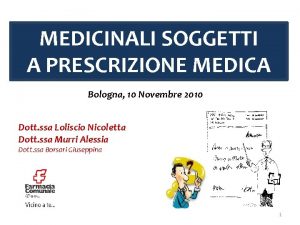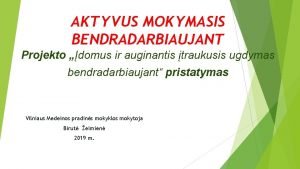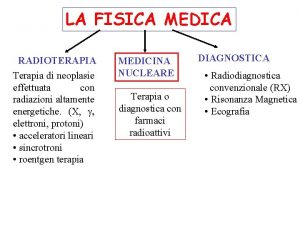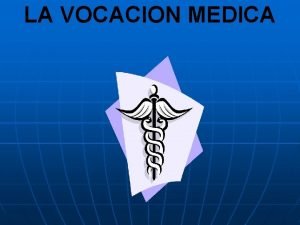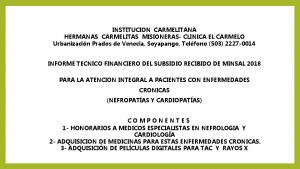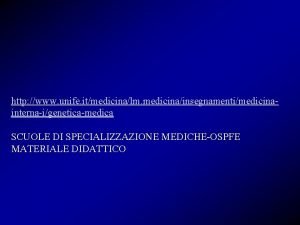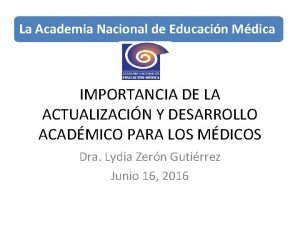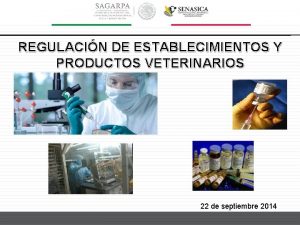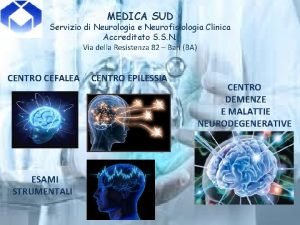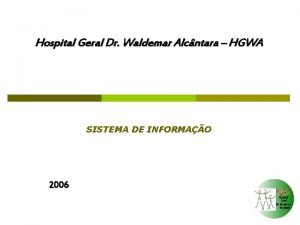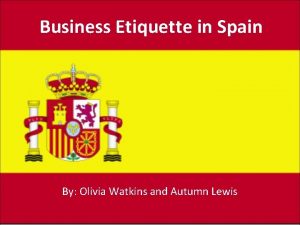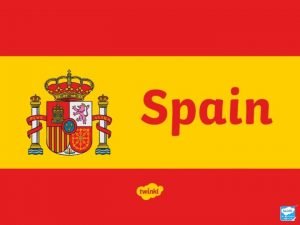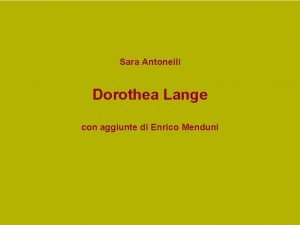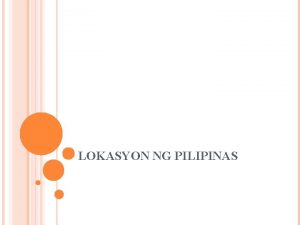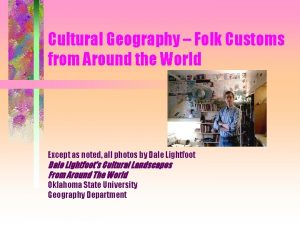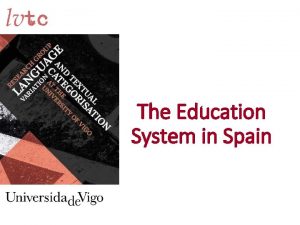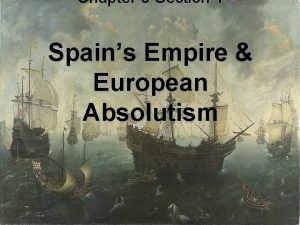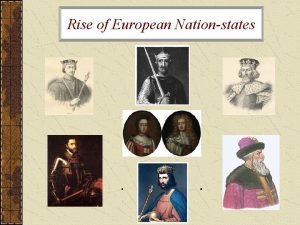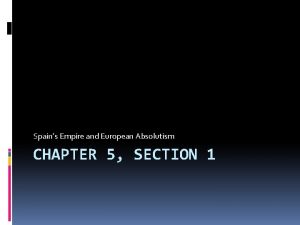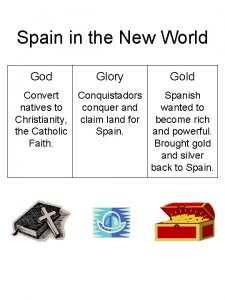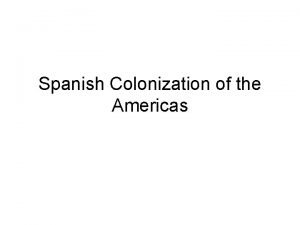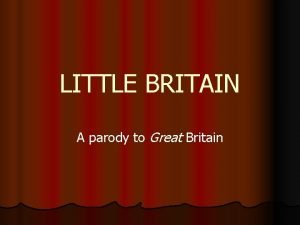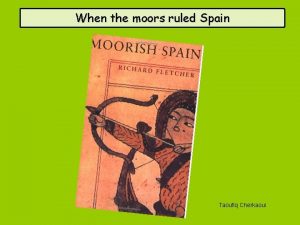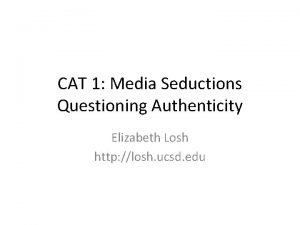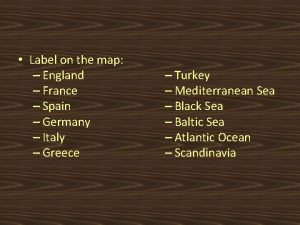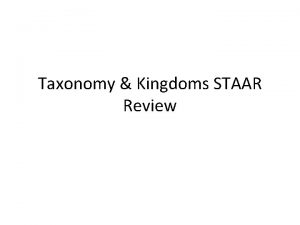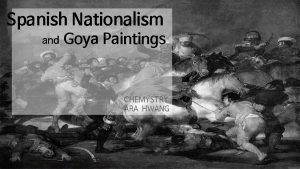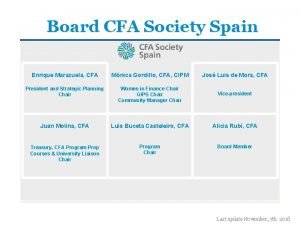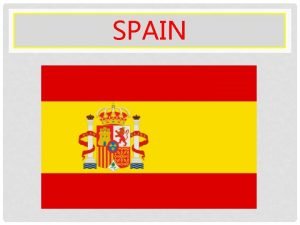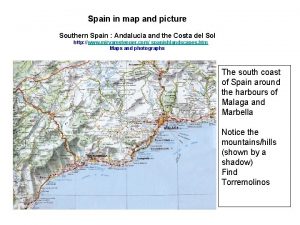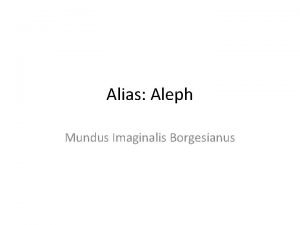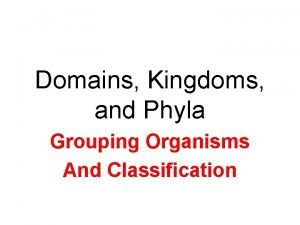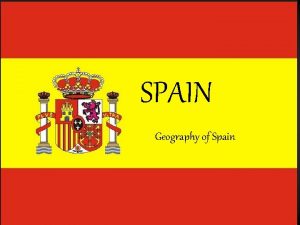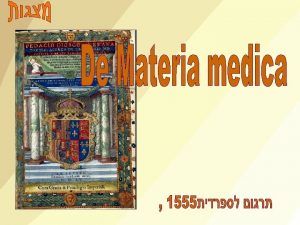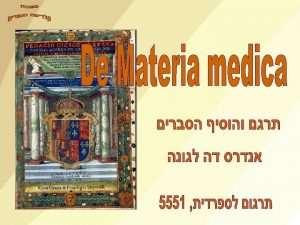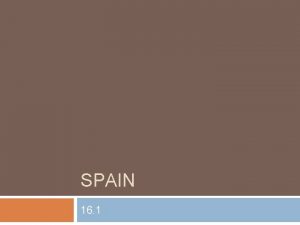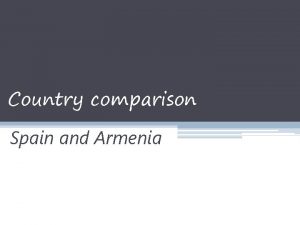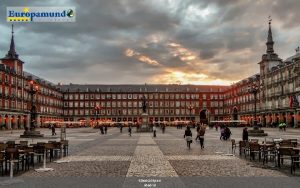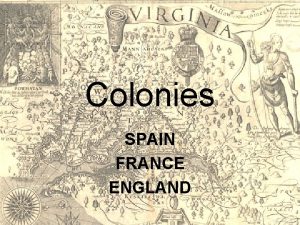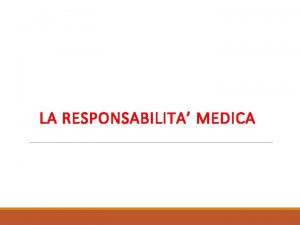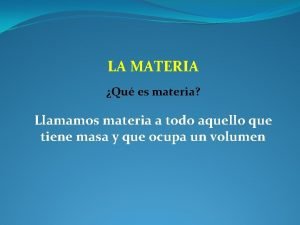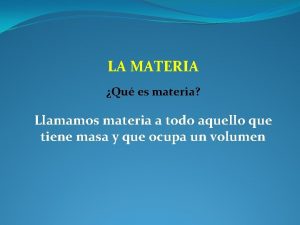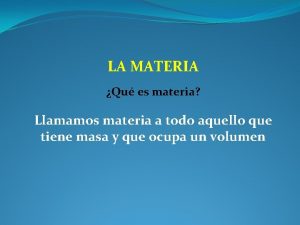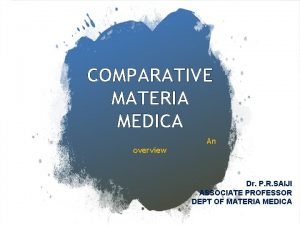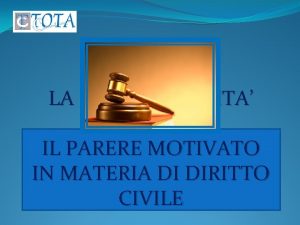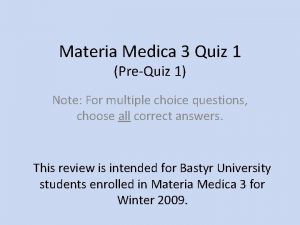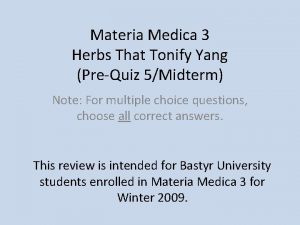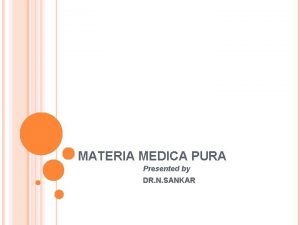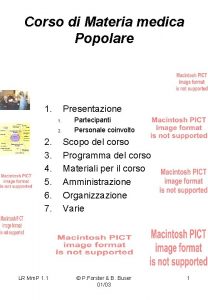Dioscorides De Materia Medica Spain 12 th 13












































































- Slides: 76




Dioscorides De Materia Medica, Spain 12 th 13 th century



The Vienna Dioscurides or Vienna Dioscorides is an early 6 th century illuminated manuscript of De Materia Medica by Dioscorides in Greek. It is an important and rare example of a late antique scientific text. The 491 vellum folios measure 37 by 30 cm and contain more than 400 pictures of animals and plants, most done in a naturalistic style. In addition to the text by Dioscorides, the manuscript has appended to it the Carmen de herbis attributed to Rufus, a paraphrase of an ornithological treatise by a certain Dionysius, usually identified with , and a paraphrase of Nicander's treatise on the treatment of snake bites. The manuscript was created in about 515 and was made for the Byzantine princess Juliana Anicia, the daughter of Emperor Anicius Olybrius. Although it was originally created as a luxury copy, there is some indication that in later centuries it was used daily as a hospital textbook. It includes some annotations in Arabic.

Dedicatory drawing of Imperial Princess Julian Anicia (center) in the Dioscoridean recension of 512 CE, flanked by personification of Magnanimity on her right who holds gold coins and Wisdom on her left with scroll or codex. The Cupid-like putto offers an open codex and a prostrate female represents craftsmen who restored the church in Honorata on the beneficence of the princess.

Anicia Juliana (Constantinople, 462 -527/528) was a Roman imperial princess, the daughter of the Western Roman Emperor Olybrius, of the Anicii, by Placidia the younger, daughter of Emperor Valentinian III and Licinia Eudoxia. Her glittering genealogy aside, Juliana is primarily remembered as one of the first non-reigning female patrons of art in recorded history. From what little we know about her personal predilections, it appears that she "directly intervened in determining the content, as well, perhaps, as the style" of the works she commissioned. Juliana's name is attached to the Vienna Dioscurides, also known as the Juliana Anicia Codex, one of the earliest and most lavish illuminated manuscripts still in existence. The frontispiece features her depiction, the first donor portrait in the history of manuscript illumination, flanked by the personifications of Magnanimity and Prudence, with an allegory of the "Gratitude of the Arts" prostrate in front of her. The encircling inscription proclaims Juliana as a great patron of art.







Dioscrorides and a pupil De Materia Medica of Dioscorides. by Yusuf al Mawsili Mosul, Dec. 1228.

Vienna Dioscurides פטל Rubus fruticosus. Da Dioscoride, De materia medica 1.



Plantago asiatica L. , Fam. Plantagineae V


Physallis Physalis alkekengi: Physalis, or Winter-cherry The Physalis plant grows in many parts of the world: in Europe, China, South America, South Africa, and in the United States. Often called the Winter-cherry or “Chinese Lanterns, ” physalis was used as a decorative and medicinal herb. Dioscorides prescribed its stem as a sedative and its berries as diuretics. Mixed with honey, Physalis was said to improve eyesight; with wine, it supposedly cured toothache.

Anêthon to esthiomenon

Kyklaminos Cyclamen europaeum: Cyclamen, sowbread This herb gets its name (cyclamen means “circle”) from its bulblike, underground stem. Dioscorides suggested its use as a purgative, antitoxin, skin cleanser, and laborinducer. When used as a purgative, juice from the tuberous root-stock was applied externally, either over the bowels and bladder region or on the anus. Dioscorides also mentioned its use as an aphrodisiac. Many English farmers called Cyclamen “stag-truffle” or “sowbread” since they often observed deer and swine digging up and eating the roots.

(Dipsacus silvestris L. , Fam. Compositae) aus dem Wiener Dioskurides


(Brassica rapa L. , Fam. Cruciferae)

Apsynthion Bathyprikon Artemisia absinthium: Wormwood Next to Rue, Wormwood is the bitterest herb. Dioscorides recommended it as a stomachic, a vermifuge, a remedy for jaundice, and a flavoring for absinthe. According to Dioscorides, absinthe was a popular summertime drink in Propontis and Thracia, where they believed it maintained good health. Dioscorides also recommended the use of Wormwood in clothes drawers to repel moths and mice.

Kentaureion to lepton Erythraea centaurium: Centaury The genus of this herb was originally named Chironia after Chiron, a centaur of Greek mythology who was famous for his knowledge of medicinal plants. According to legend, Chiron healed himself with this plant after accidentally wounding himself with one of Hercules’s poisoned arrows. Dioscorides alluded to the myth and prescribed Centaury as a treatment for wounds. He also recommended the herb for lung disorders, namely “the old cough” and “blood spitting. ” http: //www. hsl. virginia. edu/historical/rare_books/herbalism/vienna. cfm

Panax Heraklios probably Ferula galbaniflua: Galbanum The genus of this plant (panax means “universal remedy”) suggests its wide use among the ancient Greeks. Dioscorides prescribed the milky juice of Galbanum for ulcers, coughs, convulsions, ruptures, headaches, stomach pains, menstrual cramps, toothaches, snakebites, and labor pains. Rubbed on the eyes as an ointment, it improved eyesight. And taken with honey, Galbanum was a sure remedy for indigestion and flatulence.


Rosa lutea: Rose The beauty and fragrance of the rose secured its popularity in the ancient world. The Greeks associated the rose with Aphrodite, the Graces, and the Muses. Dioscorides recommended rose petal paste as an eye salve and suggested a decoction of rose petal dust in wine for headaches, earaches, and hemorrhoids. He also prescribed a rose hip decoction against hemoptysis.

גדולה עירית Asphodelus ramosus. Da Dioscoride, De materia medica,

Aeizon to Mikron (Sempervivum tectorum) in Codex Vindobonensis




(Dipsacus silvestris L. , Fam. Compositae) Wiener Dioskurides

Materia Medica ב שצוירה כפי הסיגלית . וינה היד ובכתב שבנאפולי היד בכתב Viola, Pedanios Dioscurides Codex medicus Graecus 1 der Österreichischen Nationalbibliothek 1) Iride 2) Viola porporina Biblioteca Nazionale di Napoli - Biblioteca digitale - Dioscurides Neapolitanus

Illustration of the crisantem from the Vienna Dioscurides

Strychnos Megas Kepaios Solanum nigrum: Black Nightshade A relative of the notorious Atropa belladonna, or Deadly Nightshade, the Black, or Garden, Nightshade is potentially harmful, but its poison is relatively mild. Dioscorides recommended its leaves for treating skin diseases. He also suggested a decoction of the plant’s leaves for earaches, indigestion, and internal bleeding.

Drakontaia Mikre Arum maculatum: Arum, or Cuckoo-Pint Ancient physicians called this plant the Drakontaia Mikre, or “small dragon, ” because the central stalk resembles a serpent. According to Dioscorides, its shape revealed its purpose as an antidote for snakebites. Rubbing one’s hands with Arum root was supposed to make one unbiteable. Dioscorides also recommended the Arum root as an expectorant. The leaves, “beaten small, ” were to be used on fresh wounds. ארצה שעלו ישראל עדות ובני הפאלחים - לוף והם , בר הגדל בלוף משתמשים , ערב מארצות כמו . רבים מאכלים ומפקעותיו מעליו מתקינים שלהם העממית ברפואה משמש הוא כן , לטחורים , בליחה המלווה לשיעול כתרופה השתן בדרכי לעצירות , בבטן לתולעים . בעור ולפצעונים

Cultivated and wild carrots from the Juliana Anicia Gingidion The wild carrot Daucus gingidium. Staphylinos Keras The cultivated carrot Staphylinos Agrios The wild carrot, but appears to be a primitive type of cultivated carrot

Coral from the Vienna Dioscurides

Thalassa ‘ die Personifikation des Meeres Wiener Dioskurides.


Page from the Vienna Dioscurides (Parus caeruleus L. ) (Athene glaux) (Syrnium).

A mythical fire-dwelling salamander Vienna Dioscurides manuscript.


http: //www. hort. purdue. edu/newcrop/pdfs/JAC. pdf

The Morgan Dioscorides Circa 930 – 970 The Morgan Library & Museum, written in Greek miniscule and illuminated in Constantinople during the mid-10 th century, contains an alphabetical five-book version of Dioscorides, De Materia Medica, including 769 illustrations and several headpieces and tailpieces, on 385 leaves


An Arabic translation of the manuscript was discovered in Istanbul in the 1560 s by the Flemish diplomat Ogier Ghiselin de Busbecq who was in the employ of Emperor Ferdinand I. The Emperor bought the manuscript and it is now held in the Österreichische Nationalbibliothek in Vienna. The manuscript was inscribed on UNESCO's Memory of the World Programme Register in 1997 in recognition of its historical significance This illustration from Walters depicts thymelaea (spurge-laurel) (thumala, khamala). This is an illustrated manuscript of the Arabic version of De materia medica by Dioscorides, copied in the thirteenth CE in Iran.

Preparation of Medicine from Honey: Leaf from an Arabic translation of the Materia Medica of Dioscorides, dated 1224 Iraq, Baghdad School Colors and gold on paper Among the Greek scientific texts that appealed to the Arab translators and artists of Baghdad, a center for manuscript production in the thirteenth century, were herbals and bestiaries. They described the appearance, habitat, salient characteristics, and uses of various plants and animals, a tradition going back to late antiquity, but pictorially were more often influenced by the art of Byzantium. Particularly popular was the treatise of Dioscorides, a Greek physician working in the Roman army in Asia Minor during the first century A. D. Deep in thought, shaded by trees, a physician stirs his medicine. In the center, a mixture is brewing in a cauldron that hangs from a tripod and is heated by the fire below. To the left, a large jug perhaps held honey or oil. While some miniatures illustrating this scientific text on medicinal uses, principally of plants, rather closely follow their Byzantine prototypes, others, such as this example, reveal more of a human than scientific approach, as the doctor seems to ponder the formula he is mixing. The decorative trees help to contain as well as balance the composition. The lack of spatial depth combined with clarity of design, lively forms, and bold coloring are characteristic of this school of painting.

A Leaf from an Arabic translation of the Materia Medica of Dioscorides ("The Pharmacy"), dated 1224 Iraq, Baghdad School

. De materia medica Abû Sâlim al-Malatî (Traducteur) Dioscorides

Pedanius Dioscorides - Folio from an Arabic translation of the Materia Medica by Dioscorides calligrapher: Abdallah ibn al-Fadl 1224

De materia medica Abû Sâlim al-Malatî (Traducteur)

De materia medica Abû Sâlim al-Malatî (Traducteur) orchidée ; plante aromatique ; plante médicinale ; sauge

Preparación de un antídoto. Materia Médica de Dioscórides. (Tomado de Fundación el Legado Andalusí)

Illustrated manuscript of the Arabic version of De materia medica by Dioscorides, copied in the seventh century AH / thirteenth CE in Iran. Pedanius Dioscorides wrote his treatise on medicinal plants in the first century CE. It was translated into Syriac and then Arabic in Baghdad in the third century AH / ninth CE. De materia medica by Dioscorides was one of the earliest scientific manuscripts to be translated from Greek to Arabic. The Walters' leaves illustrate five plants: wild cucumber, mezereon (spurge-olive), and three varieties of thymelaea (spurge-laurel). Arabic version of Dioscorides' De materia medica, Wild cucumber, Walters Manuscript

Arabic version of Dioscorides' De materia medica, Mezereon (spurge-olive), Walters Manuscript

Arabic version of Dioscorides' De materia medica, A type of thymelaea called al-sarwī, Walters Manuscript

Folio 4 r of the Arabic version of Dioscorides' De Materia Medica Iris germanica. Culture: Islamic Date: 987 -990 State University Library, Leiden

An illustration and description of a Cinnamomum tree in a 10 th-century Arabic manuscript of Dioscorides’. Dioscorides wrote that cinnamon was useful in combating a number of illnesses, from coughs to kidney diseases. STATE UNIVERSITY LIBRARY, LEIDEN

Miniature from a copy of Kitab al-hashaish, a translation of Dioscorides’s De Materia Medica. “The Doctor’s Office” Iraq, Baghdad? ; 1224 This miniature is a lovely example of the oldest preserved book painting from the Islamic world. It was made in Iraq by Abdallah ibn al-Fadl, who presumably was responsible for both copying and illustrating it. The style is an example of “Arab painting, ” in which Byzantine and local Christian pictorial conventions were still found, for example in the use of haloes and the folds of garments. The manuscript contains a number of depictions of medicinal plants. The fact that there also figurative depictions of more “unnecessary” scenes, such as this doctor’s office, has been considered by many to signify the birth of Islamic book painting.

Miniature from a copy of Kitab alhashaish, a translation of Dioscorides’s De Materia Medica. “A Ferry Crossing the Gagos River” Iraq, Baghdad? ; 1224 Like another miniature, which shows a doctor’s office (4/1997), this is one of the both unnecessary and revolutionary illustrations in Abdallah ibn al-Fadl’s copy of Dioscorides’s medical treatise. The text states that on the shores of the Gagos River, jet can be found that is effective against pain in the uterus, but the artist took the opportunity to depict an entire ferry with a helmsman, two rowers, and eight passengers, each looking out of a porthole. Despite the awkward rendition of the river landscape, the miniature is colorful and filled with finely observed and beautifully executed details.

Ibn Al Farl-Izzz "Making Lead, page from an Arabic edition of the treaty of Dioscorides, 'De Materia Medica'"


“Pedacio Dioscorides anazarbeo, Acerca de la materia medicinal y de los venenos mortiferos” traduzido de lengua griega en la vulgar castellana & illustrado con claras y substantiales annotationes, y con las figuras de innumeras plantas exquisitas y raras por Andres de Laguna 1555

In 1562, a new Czech edition of Pietro Andrea Mattioli’s Commentaries on Dioscorides entitled Herbarz: Ginak Bylinar introduced large-scale woodcuts by Giorgio Liberale allowing far more portrayal of botanical detail than had the smaller figures of earlier editions. .





: מקורות http: //en. wikipedia. org/wiki/Materia_medica http: //es. castellano/De_materia_medica http: //en. wikipedia. org/wiki/Pedanius_Dioscorides דיוסקורידס http: //he. wikipedia http: //es. wikipedia. castellano/Dioscorides http: //dioscorides. usal. es/ http: //fr. wikipedia. org/wiki/Dioscoride_de_Vienne http: //commons. wikimedia. org/wiki/Category: Vienna_Dioscurides? uselang=de https: //www=Dioscorides+De+Materia+Medica http: //www. metmuseum. org/toah/works-of-art/57. 51. 21 http: //buecher. heilpflanzen-welt. de/Dioskurides-Arzneimittellehre/ http: //oldflowerpictures. blogspot. co. il/ : Medicinal properties of Commiphora gileadensis http: //www. academicjournals. org/ajpp/pdf 2010/august/Iluz%20 et%20 al. pdf ואפרים קלריטה : שלנו לאתר להיכנס מוזמנים הנכם www. clarita-efraim. com chefetze@netvision. net. il
 Materia medica reloaded
Materia medica reloaded Ant tart materia medica
Ant tart materia medica Graphite materia medica
Graphite materia medica Kalmia materia medica
Kalmia materia medica Asterias rubens materia medica
Asterias rubens materia medica Onda p
Onda p Ingenieramédicaprogramadoraperiodistahijastra
Ingenieramédicaprogramadoraperiodistahijastra Que es rp en receta médica
Que es rp en receta médica Fisica master
Fisica master Que es la lex artis
Que es la lex artis Auditoria
Auditoria Documentos para apelar licencia medica en compin
Documentos para apelar licencia medica en compin Academia nacional de educación médica
Academia nacional de educación médica Iatrogenia medica
Iatrogenia medica Son los dos tipos de receta médica sicad
Son los dos tipos de receta médica sicad Leenwenhoek
Leenwenhoek Diceologia medica
Diceologia medica Orari dottor bigoglio caluso
Orari dottor bigoglio caluso Michelle arango xxx
Michelle arango xxx Poliedro convexo com 36 hastes e 27 esferas
Poliedro convexo com 36 hastes e 27 esferas Art. 8 legge gelli
Art. 8 legge gelli Gestin medica
Gestin medica Anestetici locali
Anestetici locali Atlas medica cartella clinica
Atlas medica cartella clinica Avaliação médica dano corporal
Avaliação médica dano corporal Ricetta ripetibile
Ricetta ripetibile Domus medica
Domus medica Specialista in fisica medica
Specialista in fisica medica Vocacion medicina
Vocacion medicina Local guide program
Local guide program Unife scuole di specializzazione
Unife scuole di specializzazione Academia nacional de educacion medica
Academia nacional de educacion medica Moto medica
Moto medica Nom-064-zoo-2000
Nom-064-zoo-2000 Giacomo losavio
Giacomo losavio Modelo de prescrição médica
Modelo de prescrição médica Business etiquette in spain
Business etiquette in spain Where is country
Where is country King phillip came over from great spain
King phillip came over from great spain Foto de dorothea orem
Foto de dorothea orem Ang dalawang lokasyon ng pilipinas
Ang dalawang lokasyon ng pilipinas Transped barcelona
Transped barcelona Spain dresses
Spain dresses System acquisition alternatives
System acquisition alternatives Educational system in spain
Educational system in spain Fly fishing in spain
Fly fishing in spain Chapter 5 section 1 spain's empire and european absolutism
Chapter 5 section 1 spain's empire and european absolutism Spanish renaissance theatre
Spanish renaissance theatre England france spain
England france spain Chapter 5 section 1 spain's empire and european absolutism
Chapter 5 section 1 spain's empire and european absolutism Russia capital
Russia capital What are the three gs
What are the three gs God glory gold spain
God glory gold spain Fill in the gaps with the right prepositions
Fill in the gaps with the right prepositions Spain cold war
Spain cold war Occupational therapy spain
Occupational therapy spain King phillip came over from great spain
King phillip came over from great spain God gold glory
God gold glory Madrid spain museum statue
Madrid spain museum statue David thomas little britain
David thomas little britain Espanyol pamahalaan
Espanyol pamahalaan When the moors ruled spain
When the moors ruled spain Land distribution meeting extremadura spain 1936
Land distribution meeting extremadura spain 1936 Inheritance tax valencia region spain
Inheritance tax valencia region spain Spain population projections
Spain population projections England france map
England france map Francis vs spain
Francis vs spain King phillip came over from great spain
King phillip came over from great spain Why did england and spain go to war
Why did england and spain go to war Bonapartist spain
Bonapartist spain Cfa institute españa
Cfa institute españa Spain population
Spain population Ats spain
Ats spain Map southern spain
Map southern spain Ccd alias spain
Ccd alias spain What kingdom is archaea in
What kingdom is archaea in Aztec farming methods
Aztec farming methods
